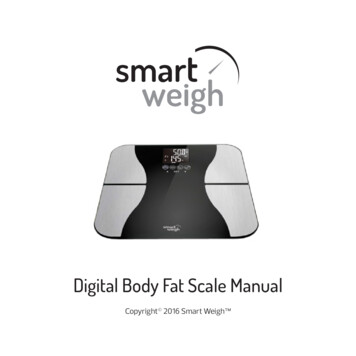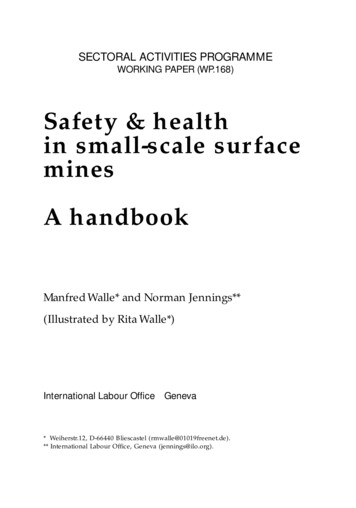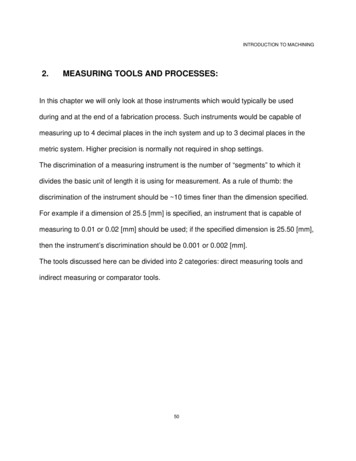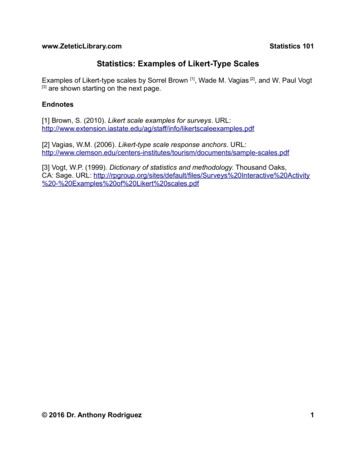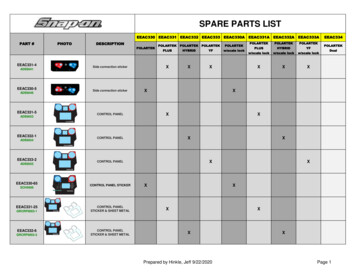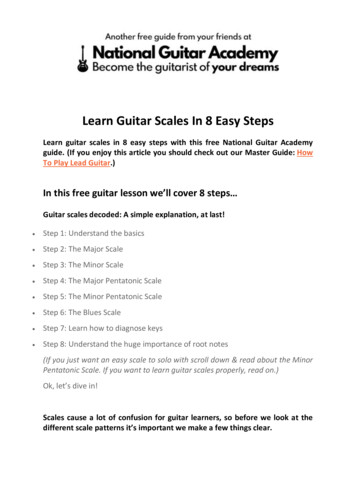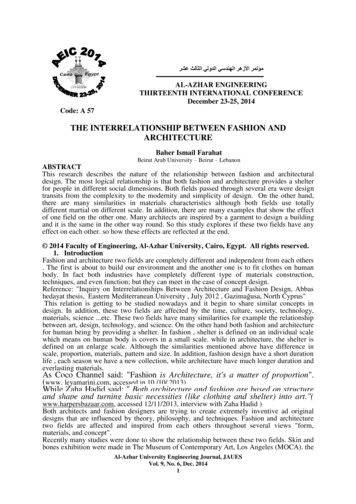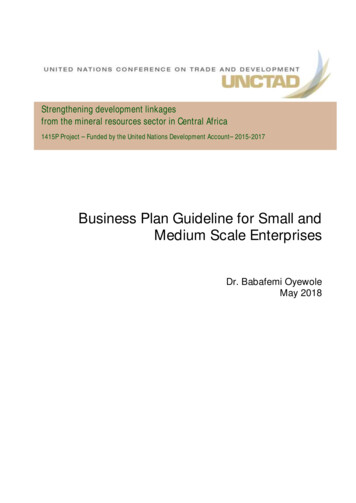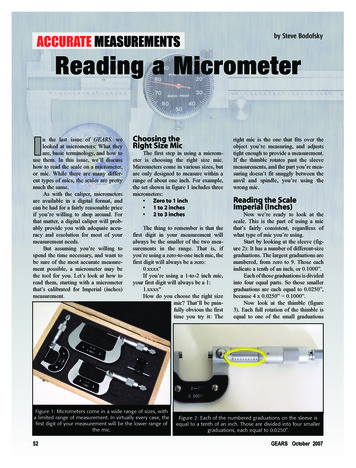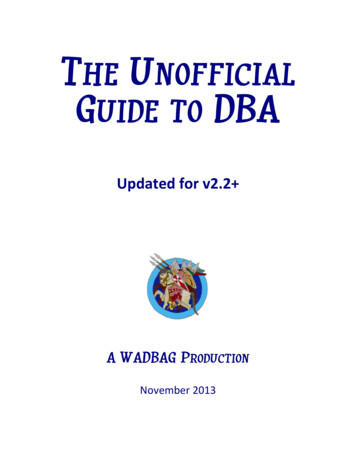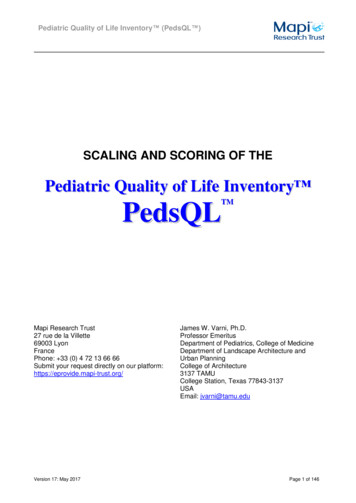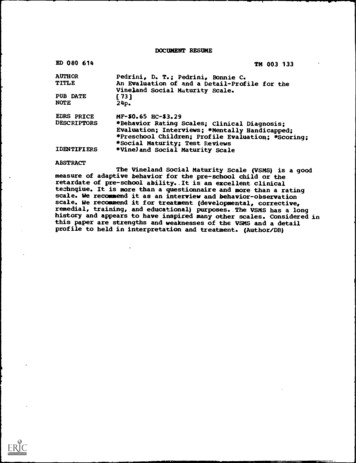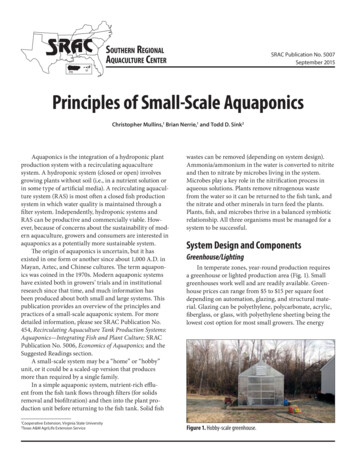
Transcription
Southern RegionalAquaculture CenterPRSRAC Publication No. 5007September 2015VIPrinciples of Small-Scale AquaponicsChristopher Mullins,1 Brian Nerrie,1 and Todd D. Sink2Aquaponics is the integration of a hydroponic plantproduction system with a recirculating aquaculturesystem. A hydroponic system (closed or open) involvesgrowing plants without soil (i.e., in a nutrient solution orin some type of artificial media). A recirculating aquaculture system (RAS) is most often a closed fish productionsystem in which water quality is maintained through afilter system. Independently, hydroponic systems andRAS can be productive and commercially viable. However, because of concerns about the sustainability of modern aquaculture, growers and consumers are interested inaquaponics as a potentially more sustainable system.The origin of aquaponics is uncertain, but it hasexisted in one form or another since about 1,000 A.D. inMayan, Aztec, and Chinese cultures. The term aquaponics was coined in the 1970s. Modern aquaponic systemshave existed both in growers’ trials and in institutionalresearch since that time, and much information hasbeen produced about both small and large systems. Thispublication provides an overview of the principles andpractices of a small-scale aquaponic system. For moredetailed information, please see SRAC Publication No.454, Recirculating Aquaculture Tank Production Systems:Aquaponics—Integrating Fish and Plant Culture; SRACPublication No. 5006, Economics of Aquaponics; and theSuggested Readings section.A small-scale system may be a “home” or “hobby”unit, or it could be a scaled-up version that producesmore than required by a single family.In a simple aquaponic system, nutrient-rich effluent from the fish tank flows through filters (for solidsremoval and biofiltration) and then into the plant production unit before returning to the fish tank. Solid fishCooperative Extension, Virginia State UniversityTexas A&M AgriLife Extension Service12wastes can be removed (depending on system design).Ammonia/ammonium in the water is converted to nitriteand then to nitrate by microbes living in the system.Microbes play a key role in the nitrification process inaqueous solutions. Plants remove nitrogenous wastefrom the water so it can be returned to the fish tank, andthe nitrate and other minerals in turn feed the plants.Plants, fish, and microbes thrive in a balanced symbioticrelationship. All three organisms must be managed for asystem to be successful.System Design and ComponentsGreenhouse/LightingIn temperate zones, year-round production requiresa greenhouse or lighted production area (Fig. 1). Smallgreenhouses work well and are readily available. Greenhouse prices can range from 5 to 15 per square footdepending on automation, glazing, and structural material. Glazing can be polyethylene, polycarbonate, acrylic,fiberglass, or glass, with polyethylene sheeting being thelowest cost option for most small growers. The energyFigure 1. Hobby-scale greenhouse.
UV-protected plastic, fiberglass, metal with liner, woodwith liner, intermediate bulk container (IBCs), or barrels.Only used bulk containers that held food-grade materialand have been thoroughly washed should be used. Ensurethat fish tanks are constructed and placed to protect smallchildren and pets from accidental drowning.Fish tanks should be covered to prevent fish fromjumping out, keep out predatory birds, and reduce algalgrowth. Shade cloth, foam board, and netting can be usedto cover tanks. Covers should not hinder the fishes’ accessto floating feed.Plant UnitFigure 2. Thermal solar panels.cost for heating (propane, natural gas, electricity, etc.)can become a large expense and may make small-scaleproduction in temperate regions cost prohibitive. Growers should investigate alternative methods of heating thegreenhouse or system water, such as geothermal water,in-pond heat exchangers, solar (Fig. 2), and wood heat.An alternative to a greenhouse is a well-insulatedspace that has good lighting. While not as good as natural sunlight, improved lighting technology has providedchoices such as compact fluorescence, high-pressuresodium, metal halide, high-intensity discharge lamps,LED (light-emitting diode), and induction. High-intensitydischarge lamps and fluorescent are the most cost-effective options and provide better photosynthetically activeradiation (PAR) values for plant growth. LEDs are notinexpensive to purchase and have yet to be proven viableas the sole source of light for adequate plant growth.The plant growth units most often used are mediabeds, nutrient film technique (NFT), and deep water culture (DWC, sometimes referred to as raft culture).Media beds are easy and inexpensive to set up andcan be a good choice for small-scale systems. A media bedsystem (Fig. 3) is some type of container that holds mediafor plants to grow in. The media supports the roots of theplants and can act as a biofilter and solids filter. Typesof containers used most often are 4-foot 8-foot linedwooden beds, intermediate bulk containers (IBCs), andbarrels. Beds either go through cycles of being floodedand drained or water flows through them continuously.Water should rise to only 1 inch from the top of the mediato prevent excess algal growth, which encourages pests.Pumps, timers, and/or a bell siphon can move water fromthe fish tank to the plant unit and then back to the fishtank. Media used in beds includes river rock (which hastested free of limestone), expanded clay pebbles, plasticbiomedia, vermiculite, and perlite, although perlite isless used now because of its undesirable characteristics.Fish UnitThe first management component of the small-scaleaquaponic system is the fish tank from which the nutrients for plant growth will be obtained. Generally, thefish tank volume is less than 500 gallons; the average is300 gallons. One pound of fish per 10 gallons of water isa common final density at the time of harvest for new orinexperienced growers, but the density can vary greatlydepending on grower experience, system design, andwhether or not solids are removed.Although any shape tank is acceptable, since smallscale units may not be intensively operated, the bestdesign is a circular tank with a central drain for easy selfcleaning of settled solids. Tanks can be constructed from2Figure 3. Media bed filled with vermiculite.
Collected rocks should be evaluated to make sure they donot contain limestone, which will increase alkalinity andcause an undesirably high pH (see below).While the ability of the media to act as a filter adds tothe simplicity of system design, it necessitates the need tomanage and clean the media periodically. Otherwise, itwill become clogged and create anaerobic zones. In somedesigns, worms (the same types used in vermicompostingsystems) are added to the media to help digest solid material trapped by the media. Usually a small fraction of thebed retains water all the time. Media depth can vary withthe type of plant being grown and the depth of its rootzone, but most media beds are 6 to 12 inches deep. Startedseedlings are transplanted into the media, as direct seeding does not work well in aquaponic systems.Nutrient film technique (Fig. 4) is a system that useshorizontal pipes or gutters for growing the plants. Specially made channels or PVC pipes (Fig. 5) are used tosupport the plants and convey the fish tank effluent pastthe roots of the plants and back to the fish tank. Channels should be sloped approximately ½ inch per 10 feet toallow for easy drainage through the channel. This systemalso allows for vertical arrangement of the channel tomaximize yield per square foot (Fig. 6). Channels canFigure 5. NFT production channels made from PVC pipe.Figure 6. NFT channels arranged vertically to maximize production.Figure 4. Commercially manufactured NFT production channels.vary in length and are generally less than 12 feet long.Spacing between channels and hole spacing in channelsdepends on the size of the plants being grown. Channelsfor lettuce are usually spaced 8 inches apart with 8 inchesbetween holes in the channel.Seedlings are placed in holes in the channel andremain there through harvest.Seeds are started in media cubes or pellets, or in netpots filled with clay pebbles, soilless media, or rockwool.Seedlings are planted into the holes in the pipes, wherethey sit directly on the bottom or slightly raised up, due topipe design or placement. Hole size depends on whethercubes or net pots are used.Deep water culture (Fig. 7) or floating bed/raft bedis a system that grows plants on a floating raft on waterfrom the aquaculture system. Like the NFT system, fishtank effluent moves through filters and then to the floatbed before returning to the fish tank. Also like the NFTsystem, DWC is more management intensive and costlyfor the beginning grower than the media bed system.3
Figure 7. Deep-water culture.Float beds can be built on the ground of dimensionallumber and lined with plastic. Or, they can be built ofconcrete, cinder blocks, or fiberglass. In the case of air liftand gravity flow systems, the beds may be elevated so thewater can flow unaided by pumps through filter media orinto a central sump. Polyethylene or fiberglass containers,such as IBCs and barrels, can be used as trays or troughs.The length and width of the beds are based on the dimensions of the float trays to make sure the bed is covered toprevent algal growth. Generally, a depth of 10 to 12 inchesis adequate for plant root development, but beds as shallow as 6 inches will work in many instances. Rafts can bepurchased specifically for certain plants, or they can bemade by making planting holes in closed-cell polystyreneinsulation board (regular polystyrene will break apart).Hole spacing depends on the plant, but an 8-inch spacingwill work for most leafy greens. Like NFT systems, seedsare started in media cubes or net pots filled with media.To insure proper aeration for the roots, air stonesshould be placed in the float bed—one for every 10 squarefeet. Since nitrifying microbes colonize the rafts, therafts should be washed with water to remove algae anddebris but should not be allowed to dry out and kill thosemicrobes.The height of beds should ensure easy access from allsides.tanks/clarifiers. Screen filters and settling tanks tend to bethe simplest for small-scale systems.The screen filter or settling tank is placed directlyafter the fish tank and before the biofilter. A solids settlingtank would consist of a dedicated tank that has an inlet,outlet, and some type of baffle system, screen, or waterflow diffusing media. As water enters the tank, it slowsdown and allows solid material to settle to the bottom ofthe tank where it can be removed by a siphon or bottomdrain. Meanwhile, the clear water passes on to the biofilter. Figure 8 shows a swirl or vortex separator, wherewater enters the tank at an angle to create a swirl effecton a conical bottom tank and pushes solids down so thatclear water leaves the tank near the top. The design of asolids settling tank depends on water flow rate and retention time.BiofiltrationBiofiltration is the chemical process by whichmicrobes convert ammonia to nitrite and then to nitrate.This process, called nitrification, can occur on every surface the system water contacts. In many systems there is adedicated area for this to happen, a biofilter tank. Like theclarifier, the biofilter tank should contain 15 to 20 percentof the volume of the fish tank. The biofilter tank (Fig. 9)needs two things: media that has a high surface area forSolids RemovalFish waste and uneaten food pose a problem foran aquaponic system because this material can quicklylead to toxic conditions for fish and ultimately clogsystems and disrupt water flow. Much of this waste canbe removed with filters (clarifiers) such as bead filters,screens, drum filters, vortex filters, and solids settling4Figure 8. Swirl separator.
ManagementDaily and overall management of the aquaponicsystem is critical for success. Fish management involvesspecies selection, fry/fingerling procurement, scheduling,stocking rates, and feeding rates. Management areas forplants include seed selection, propagation, water quality, planting, harvest, post-harvest, scheduling, and pestmanagement.Fish ManagementFigure 9. Biofilter tank.The types of fish produced depend on the intendeduse, availability, ease of maintenance, and water temperature. Fish may be produced for consumption, for ornamental uses, and for bait. However, the purpose of aquaponic systems is food production. Without a fish speciesto be harvested for food or sold to offset production costs,it is more economically feasible to operate a pure hydroponic system for the plants. Many species of foodfish canbe grown in aquaponic systems in the southern region,including hybrid striped bass, channel catfish, largemouthbass, bluegill, and hybrid sunfish. This publication willfocus on tilapia (Fig. 10), as they do well in aquaponicsystems and are arguably the most frequently used speciesin commercial aquaponic operations.nitrifying bacteria to colonize, and sufficient aeration forthe bacteria. Biofilter media can be bought commerciallyand will have a high surface area to volume ratio. Growersalso can use other material such as plastic bottle caps, lavarock, or packaging material. The media should be inert,easy to clean in de-chlorinated water, and lightweight.Since the microbes that colonize the media need tooperate in an oxygenated environment, aeration is important. Dissolved oxygen levels in the biofilter tank shouldbe maintained at more than 5 ppm. Stirring the mediaoccasionally will maintain its efficiency by ensuring thatwater flow does not bypass active surface areas. See SRACPublication Nos. 451, 452, and 4502 for more informationon biofiltration in tank systems.Movement of WaterWater movement involves the device to move thewater, the piping system, and gravity. A single air-lift oroil-free submersible water pump should be located at thelowest point, which is the bottom of the sump. When apool style centrifugal pump is used, the pump should belocated at the sump outlet. Gravity is used to lower thecost of water movement throughout the system. Whenever possible, the grower should use oversized pipes toavoid any clogging that can occur.Figure 10. Tilapia production tank with netting.5
Tilapia tolerate a broad range of water quality andenvironmental conditions, reproduce volitionally andfrequently at acceptable water temperatures, and areresistant to stress-related disease. Potential drawbacks oftilapia are their availability, local/state regulations, andtheir limited growth at water temperatures below 68 F(they are tropical fish). Depending on the species (whichmay also be mandated by local/state regulations), tilapiamay start to die at temperatures of 55 F to 45 F andbelow. Most tilapia species suitable for food culture growbest at about 85 F.At least one tilapia species is readily available in mostof the southern region. However, in a few southern areas,and in other regions, tilapia may not be widely available.In these instances fish may have to be air-shipped orpicked up by the producer from distant reliable suppliers.Using mono-sex male tilapia may increase production because males grow larger and more uniformly thanfemales. If a mixed-sex populations is used, the producereventually will have to manage the offspring. Offspringshould be removed from the system and can be transferred to aerated tanks until used to replace harvested fishin the aquaponic system. Check with the local Cooperative Extension office or state fish regulatory agency to besure that all permits and regulations on fish productionare understood. See SRAC Publication Nos. 280, 281, 282,and 283 for more information on the biology and cultureof tilapia.Fish consume pelleted food and release nutrients thatcan be used by plants. A simple system can be stockedwith multiple size tilapia in a highly aerated tank. Whenlarger fish are harvested, replacements are stocked. Asingle-sized pellet can be consumed by both the smallerand larger fish. Floating food pellets that contain 28 to 36percent crude protein should be offered to tilapia. Certain species such as koi may require as little as 22 percentprotein, while other species such as hybrid striped bassmay require 40 percent or more protein. Pellets should besmall enough to be consumed by fish more than 2 incheslong. For smaller fish, pellets can be mashed into a powder, but higher protein concentrations are often required.Feed should be stored in a cool, dry environment, preferably in a sealed container to keep out insects or rodents.The University of Virgin Islands recommends feeding2 to 4 ounces of fish food per day to support 10 square feetof plants in raft aquaponics (56 to 100g feed/m2/day). Ifusing the nutrient film technique (NFT) production system, the feeding rate would depend on the plant speciesand system design and area, but would generally be only25 to 75 percent of the raft feeding rate.Although keeping the water warm in winter may be6costly and plants may not be growing during this period,tropical fish species must have warm water, and temperatefish can be harmed by toxic nitrogen concentrations thatcan occur if fish are fed without actively growing plants.Temperatures necessary for tropical fish can be artificiallymaintained with heaters, but in-tank units should be protected to prevent the fish from damaging them.Daily maintenance includes observation, feeding,draining/siphoning of settleable solids, and recordingdata such as pH (the most critical), dissolved oxygen, temperature, feeding activity, and quantity fed. Fish shouldnot be handled unless absolutely required.Settleable solids removed from the fish tank can beapplied to gardens in some states, but not all. Be sure tocheck with local and state regulatory agencies for regulations pertaining to wastewater discharge and manureapplication to edible raw crops.Plant ManagementCrop selection is very important, as the grower wantsto match fish and plants that have similar requirementsfor pH and temperature. The quality and quantity of foodprovided to the fish should be matched with the nutrientneeds of the crops.Many plants can grow successfully in an aquaponicsystem. More than 100 types have been grown in the last20 years. Culinary herbs and leafy greens perform welland are a great choice for beginning growers. Lettuce,basil, swiss chard, pak choi, and watercress are examples.These crops have lower nutrient requirements than manyothers. Fruiting crops such as peppers, cucumbers, andtomatoes require additional nutrients and possibly atdifferent periods of their growth. One advantage of leafygreens is that they can be grown with static nutrient levelsthroughout the life of the crop, which is ideal for smallscale aquaponics.The production system design plays a role in plantselection. Low-growing plants work well in all systems,while trellised crops such as tomatoes, melons, and peppers work best grown on the ground in media-basedsystems. Dutch bucket production (Fig. 11), essentially amedia bed system, can work well for trellised crops.Plants require 16 essential nutrients. An aquaponicsystem provides these from the air, the water, and thebreakdown products of fish. Nutrients are a function ofthe food fed to the fish. A general guideline for feedingis 2 to 4 ounces of fish food per 10 square feet of plantproduction area. (For more information on nutrient ratesand ratios, see SRAC Publication No. 454, RecirculatingAquaculture Tank Production Systems: Aquaponics—Integrating Fish and Plant Culture.) Having too much of a
Figure 11. Dutch bucket tomato production.certain nutrient (toxicity) is rare in an aquaponic system.However, even in a balanced system some nutrients suchas iron, potassium, and calcium may be deficient andwill have to be added to the system. They are generallyadded as chelated iron, potassium hydroxide, and calciumhydroxide. The first is slowly released over time, and thelatter two add minerals and raise pH. Symptoms of deficiencies include chlorosis, tip burn, blossom end rot, andyellow leaves. The level of pH can affect the ability of aplant to take up certain nutrients. Most plants adapted foran aquaponic system have an optimum pH of 6.2 to 6.5; atlevels below and above that, certain nutrients become lessavailable to the plant.Growers should keep a constant supply of seeds, especially those with short maturity time. This will eliminatedowntime between planting and harvest. Seeds shouldbe kept in dry, cool storage to prevent poor germination.Most leafy greens will be started from seed about 2 weeksbefore planting into the system, but tomatoes and peppersrequire a longer starting time. Some growers build a subirrigation propagation area or table where media can beplanted and watered. Similar to a float bed, this could bea lined wood table or other container that can be floodedand drained.Transplanting seedlings into the system can be donein a staggered manner to allow for a weekly or timedharvest, which will maintain a more constant supply ofnutrients and keep the water filtered.Plants and fruit should be harvested when mature andnot left in the system for too long. Lettuce can turn bitteras it overmatures, and fruit can develop fungus problems.Follow good agricultural practices such as washing handsbefore harvest. Make sure to remove all plant material fromthe area, such as roots and leaves stuck in the media bed.Whether in an enclosed structure or outside, insectpests can be a problem. Typical pests found in aquaponicsare aphids, whiteflies, spider mites, thrips, and caterpillars. Growers should use an integrated pest managementapproach (IPM) to controlling pests. This means combining mechanical, physical, biological, cultural, and chemical methods to keep pest populations in check. However,in aquaponic systems, most chemical control methodsshould not be used, as they can be potentially harmful tofish. The key to an IPM approach is to know about potential insect pests and their life cycles. Beneficial insects canbe an effective tool to control insects, especially in thegreenhouse environment. Monitoring pest populationswith yellow and blue sticky cards and using yellow stickytape (Fig. 12) is important. Be sure to scout under leavesand in blooms to detect insect problems.Figure 12. Use of yellow sticky tape to trap insects in tomato production.Water QualityWater quality is critical to a successful system. Certain parameters such as dissolved oxygen, temperature,pH, and total nitrogen should be tested weekly. For someparameters, a compromise should be reached for fish,plants, and microbes.Small-scale aquaponic systems lose 1 to 5 percent ofsystem water each day through evaporation, transpiration, plant assimilation, and splashing. Good qualitywater should be used to replace lost water. Sources can bemunicipal, ground, or rainwater, but should be tested forsuitability. For example, municipal water is often treatedwith chlorine or chloramines that could be harmful toorganisms in the system. Making this water safe mightinvolve letting it sit or “off gas” or, in the case of chloramines, using a dechlorinating treatment such as sodiumthiosulfate. An inexpensive way to treat municipal wateris to use 500 milligrams ascorbic acid (Vitamin C) per 50gallons of reservoir water to rapidly remove chloramines.7
Temperature should be a consideration when selecting fish species and plant types. Crops with similar temperature requirements should be cultured together. Forexample, warm water fish like tilapia and a warm seasoncrop like basil should be grown together. DWC systemshold onto heat better than NFT systems, as the pipes tendto give back heat to the environment. An optimum rangefor warm water fish and warm growing season plants is72 F to 90 F, while winter crops and cool water speciesdo well in temperatures from 50 F to 68 F.pH is the relative quantity of H ions in solution andis a measure of the acidity and basicity of a solution. A pHof 7 indicates a neutral level, with 7 being acidic and 7being basic. While most fish can tolerate a broad rangeof pH levels (5.5 to 10.0 acceptable, 6.5 to 9.0 desirable,see SRAC Publication No. 4606, Interpretation of WaterAnalysis Reports for Fish Culture), plants can show nutrient deficiencies and microbes become less effective at narrower pH ranges. For aquaponics, a pH range of 6.5 to 7.5should be maintained. Plants absorb some nutrients betterat slightly acidic pH ranges, while microbes nitrify betterat slightly to moderately alkaline pH ranges. Therefore,a moderate pH range of 6.8 to 7.2 is often recommended,but may be too restrictive for all situations and systems.One of several processes in the system that affects pH isnitrification. As microbes convert ammonia to nitrate Hions are released, thus lowering pH. In many systems, thismakes it necessary to add a base (potassium hydroxideand calcium hydroxide).Dissolved oxygen levels above 5 ppm are ideal for fish,plants, and microbes in the system. Oxygen is dissolvedfrom the air into water, but it is necessary to provide supplemental aeration by means of air diffusers in the water.Growers should remember that as temperature increases,the solubility of oxygen decreases.ConclusionA small-scale aquaponic system cannot provide allthe food a family requires, but it can provide a healthysource of food, promote family independence, provide afun hobby for adults and children, and possibly provide asmall income through the sale of fish and produce. Operating a small-scale aquaponic system can be rewardingand educational for a family producer.Suggested ReadingsAko, H. and A. Baker. 2009. Small-Scale Lettuce Productionwith Hydroponics or Aquaponics. Sustainable Aquaculture SA-2. College of Tropical Agriculture and HumanResources. University of Hawaii at Manoa.Diver, S. and L. Rinehart. 2010. Aquaponics—Integration of Hydroponics with Aquaculture. ATTRAIP163. National Center of Appropriate Technology –ATTRA, Butte, MT.Losordo, T., M.P. Masser, and J. Rakocy. 1998. Recirculating Aquaculture Tank Production Systems: An Overviewof Critical Considerations. SRAC Publication No. 451,Southern Regional Aquaculture Center, Stoneville, MS.Menon, R., G. Sahana, V. Shruthi, and R. Suganya. 2013.Small Scale Aquaponic System. International Journal ofAgricultural and Food Science Technology. 4(9): 941‒946.Rakocy, J., M. Masser, and T. Losordo. 2006. RecirculatingAquaculture Tank Production Systems: Aquaponics—Integrating Plants and Fish Culture. SRAC Publication No. 454. Southern Regional Aquaculture Center,Stoneville MS.Somerville, C., M. Cohen, E. Pantanella, A. Stankus,and A. Lovatelli. 2014. Small-Scale Aquaponic FoodProduction. FAO Fisheries and Aquaculture TechnicalPaper No. 589. Food and Agriculture Organization ofthe United Nations, Rome, Italy.This material is based upon work that is supported by the National Institute of Food and Agriculture, U.S. Department ofAgriculture, under award number 2010-38500-21142. Any opinions, findings, conclusions, or recommendations expressedin this publication are those of the author(s) and do not necessarily reflect the view of the U.S. Department of Agriculture.SRAC fact sheets are reviewed annually by the Publications, Videos and Computer Software Steering Committee. Fact sheets are revisedas new knowledge becomes available. Fact sheets that have not been revised are considered to reflect the current state of knowledge.The work reported in this publication was supported in part by the Southern RegionalAquaculture Center through Grant No. 2010-38500-21142 from the United StatesDepartment of Agriculture, National Institute of Food and Agriculture.8
Aquaponics is the integration of a hydroponic plant production system with a recirculating aquaculture system. A hydroponic system (closed or open) involves growing plants without soil (i.e., in a nutrient solution or in some type of artificial media). A recirculating aquacul-ture sys
